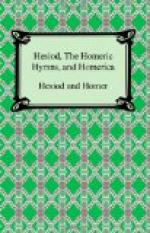These MSS. are divided into two families:
Omegaa = C,D Omegab = E,F Omegac = G,H,I Psi = K,L
“Shield of Heracles”: —
P Oxyrhynchus Papyri 689 (2nd cent.).
A Vienna, Rainer Papyri L.P. 21-29 (4th cent.).
Q Berlin Papyri, 9774 (1st cent.).
B Paris, Bibl. Nat., Suppl. Graec. 663
(12th cent.).
C Paris, Bibl. Nat., Suppl. Graec. 663
(12th cent.).
D Milan, Ambros. C 222 (13th cent.).
E Florence, Laur. xxxii 16 (13th cent.).
F Paris, Bibl. Nat. 2773 (14th cent.).
G Paris, Bibl. Nat. 2772 (14th cent.).
H Florence, Laur. xxxi 32 (15th cent.).
I London, British Museaum Harleianus (14th cent.).
K Rome, Bibl. Casanat. 356 (14th cent.)
L Florence, Laur. Conv. suppr. 158 (14th cent.).
M Paris, Bibl. Nat. 2833 (15th cent.).
These MSS. belong to two families:
Omegaa = B,C,D,F Omegab = G,H,I Psia = E Psib = K,L,M
To these must be added two MSS. of mixed family:
N Venice, Marc. ix 6 (14th cent.).
O Paris, Bibl. Nat. 2708 (15th cent.).
Editions of Hesiod: —
Demetrius Chalcondyles, Milan (?) 1493 (?) ("editio
princeps”,
containing, however,
only the “Works and Days").
Aldus Manutius (Aldine edition), Venice, 1495 (complete
works).
Juntine Editions, 1515 and 1540.
Trincavelli, Venice, 1537 (with scholia).
Of modern editions, the following may be noticed: —
Gaisford, Oxford, 1814-1820; Leipzig, 1823 (with scholia:
in
Poett. Graec.
Minn II).
Goettling, Gotha, 1831 (3rd edition. Leipzig,
1878).
Didot Edition, Paris, 1840.
Schomann, 1869.
Koechly and Kinkel, Leipzig, 1870.
Flach, Leipzig, 1874-8.
Rzach, Leipzig, 1902 (larger edition), 1913 (smaller
edition).
On the Hesiodic poems generally the ordinary Histories of Greek Literature may be consulted, but especially the “Hist. de la Litterature Grecque” I pp. 459 ff. of MM. Croiset. The summary account in Prof. Murray’s “Anc. Gk. Lit.” is written with a strong sceptical bias. Very valuable is the appendix to Mair’s translation (Oxford, 1908) on “The Farmer’s Year in Hesiod”. Recent work on the Hesiodic poems is reviewed in full by Rzach in Bursian’s “Jahresberichte” vols. 100 (1899) and 152 (1911).
For the “Fragments” of Hesiodic poems the work of Markscheffel, “Hesiodi Fragmenta” (Leipzig, 1840), is most valuable: important also is Kinkel’s “Epicorum Graecorum Fragmenta” I (Leipzig, 1877) and the editions of Rzach noticed above. For recently discovered papyrus fragments see Wilamowitz, “Neue Bruchstucke d. Hesiod Katalog” (Sitzungsb. der k. preuss. Akad. fur Wissenschaft, 1900, pp. 839-851). A list of papyri belonging to lost Hesiodic works may here be added: all are the “Catalogues”.




